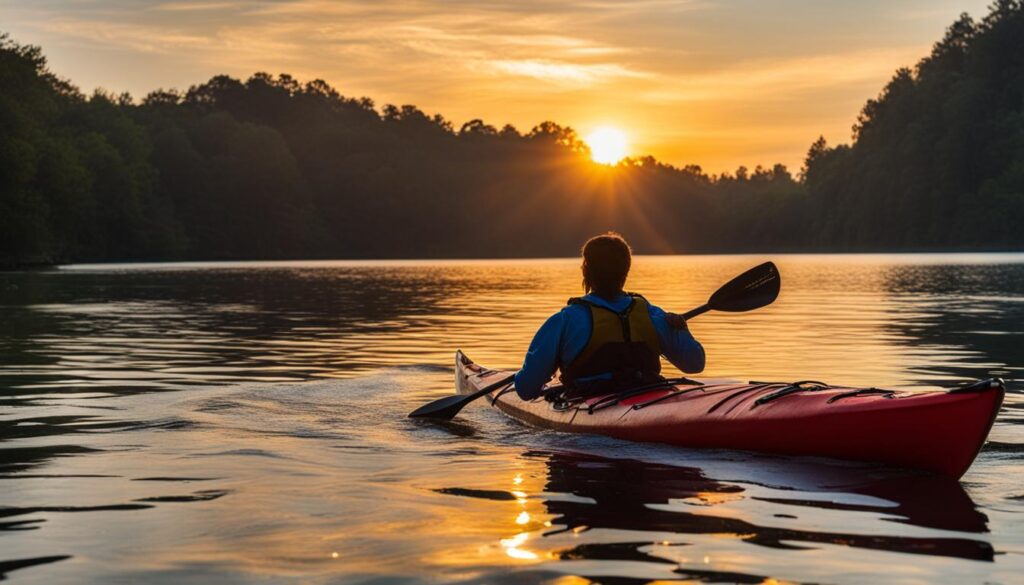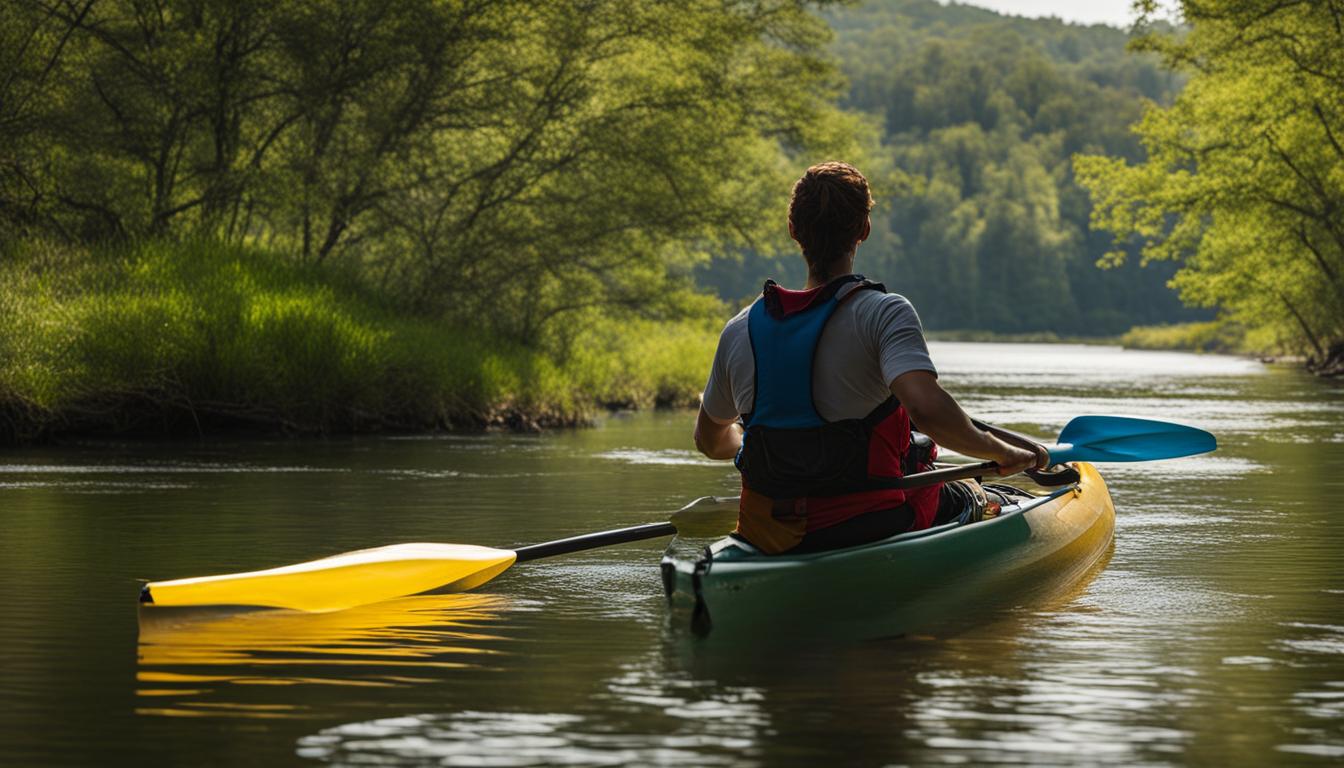Proper stretching after kayaking can make a world of difference in how your body feels and recovers. By incorporating post-kayaking stretches into your routine, you can alleviate muscle soreness and fatigue, allowing yourself to enjoy this thrilling water activity pain-free.
To help you prevent post-kayaking soreness, we have compiled a list of effective stretches that target the major muscle groups used in paddling, such as the shoulders, chest, and hips. By including these stretches in your post-kayak routine, you can enhance your recovery and keep your body in top shape.
Key Takeaways:
- Incorporating post-kayaking stretches can help prevent muscle soreness and improve recovery
- Target major muscle groups used in paddling, such as shoulders, chest, and hips
- Hold stretches for at least 30 seconds on each side and repeat at least twice
- Stretching can alleviate muscle tightness and help prevent injuries
- Make sure to prioritize safety on the water and always wear a lifejacket
Warm-up Stretches to Prepare Your Body for Paddling
Before you hit the water and embark on an exciting kayaking adventure, it’s crucial to properly warm up your muscles to enhance circulation, flexibility, and prevent injuries. Incorporating a few simple warm-up stretches into your pre-paddling routine can make a significant difference in your overall performance and enjoyment.
To target the front of your chest and shoulders, you can start with shoulder and wrist circles. Stand tall with your feet shoulder-width apart, and let your arms hang by your sides. Slowly rotate your shoulders forward in circular motions, gradually increasing the range of motion. Next, rotate your wrists in circles, first in one direction and then in the other. This will help loosen up the joints and increase blood flow to the upper body.
To further stretch the front of your chest, hold the paddle at either end and place the shaft behind your head. Gently push your chest forward while keeping your back straight. You should feel a gentle stretch across the front of your shoulders and chest. Hold this stretch for about 15-30 seconds, taking deep breaths to relax and allow your muscles to lengthen.
Another effective stretch for the shoulders involves placing one arm straight across your body. Use your other arm to gently pull it closer to your chest, feeling a stretch in the back of the shoulder. Hold this position for 15-30 seconds, then switch sides. This stretch helps to improve mobility and flexibility in the shoulder joint, which is essential for paddling movements.

Remember to start your kayaking session with a gentle warm-up, gradually increasing the intensity of your strokes to avoid overexertion. By incorporating these warm-up stretches into your routine, you’ll be ready to paddle with confidence and reduce the risk of muscle strain or injury.
Strengthening Exercises for Paddling
While paddling may seem like it primarily requires upper body strength, it is important to strengthen all muscles involved in the activity. This includes the rhomboid muscles between the shoulder blades, which are responsible for scapular retraction. By incorporating specific strengthening exercises into your routine, you can enhance your performance, prevent overuse injuries, and improve overall paddling experience.
The Role of Rhomboid Muscles
The rhomboid muscles play a crucial role in paddling as they help stabilize the shoulder blades, allowing for efficient movement and power generation. Strengthening these muscles can improve your paddling technique and reduce the risk of strains or imbalances. One effective exercise to target the rhomboids is prone swimmers. To perform this exercise, lie face down with your arms extended overhead, thumbs pointing towards the ceiling. Lift your arms and chest off the ground, squeezing your shoulder blades together and slowly lower back down. Repeat this motion for desired repetitions.
Core and Lower Body Strengthening
While the upper body is heavily engaged in paddling, it is equally important to strengthen your core and lower body muscles. A strong core provides stability and power transfer between the upper and lower body, enhancing overall performance. Bird dogs and dead bugs are excellent exercises to engage and strengthen the core. For bird dogs, start on all fours and extend one arm forward while extending the opposite leg backward. Hold this position briefly, then return to the starting position and alternate sides. Dead bugs involve lying on your back with your arms extended towards the ceiling and your legs bent at a 90-degree angle. Slowly lower one arm and the opposite leg towards the ground without arching your back, then return to the starting position and repeat on the other side.
To further challenge your core and replicate paddling motions, consider incorporating woodchoppers into your routine. This exercise mimics the rotational movement of paddling and engages the obliques and other core muscles. Stand with your feet shoulder-width apart, holding a weight or resistance band with both hands. Start with the weight or band at one side of your body and then rotate your torso, bringing the weight or band across your body and above the opposite shoulder. Control the movement as you return to the starting position and repeat on the other side.
| Exercise | Target Muscles | How to Perform |
|---|---|---|
| Prone Swimmers | Rhomboids, Back, Shoulders | Lie face down with arms extended overhead. Lift arms and chest off the ground, squeezing shoulder blades together. Lower back down and repeat. |
| Bird Dogs | Core, Back, Glutes | Start on all fours. Extend one arm forward while extending the opposite leg backward. Hold briefly, then return to starting position and alternate sides. |
| Dead Bugs | Core, Abs, Hip Flexors | Lie on your back with arms extended towards the ceiling and legs bent at a 90-degree angle. Lower one arm and the opposite leg towards the ground without arching your back. Return to starting position and repeat on the other side. |
| Woodchoppers | Core, Obliques, Shoulders | Stand with feet shoulder-width apart, holding a weight or resistance band with both hands. Rotate your torso, bringing the weight or band across your body and above the opposite shoulder. Return to starting position and repeat on the other side. |
Safety Tips for Paddlers
Kayaking can be a thrilling and enjoyable experience, but it’s important to prioritize safety on the water. Whether you’re a beginner or an experienced paddler, following these safety tips can help ensure a safe and enjoyable kayaking adventure:
Wear a Life Jacket
Always wear a properly fitting life jacket while kayaking. It can provide crucial buoyancy and keep you afloat in case of an unexpected capsize or accident. Choose a life jacket that is specifically designed for paddling and check that it is U.S. Coast Guard-approved.
Check Weather and Water Conditions
Prior to heading out on the water, check the weather forecast and water conditions. Avoid kayaking in stormy weather, high winds, or choppy waters, as these conditions can make paddling more challenging and increase the risk of accidents. If you notice any signs of lightning or thunder, it’s best to postpone your kayaking trip until conditions improve.
Let Someone Know Your Plans
Always let someone know about your kayaking plans, including your intended route and expected return time. This way, if you encounter any difficulties or unexpected delays, someone will be aware and can take appropriate action to ensure your safety.
Use Reflective Tape or Bright Colors
Visibility is important on the water, especially when paddling in areas with boat traffic. Increase your visibility by attaching reflective tape to your kayak or wearing bright-colored clothing. This will make it easier for other boaters to see you and help avoid potential collisions.
Avoid Alcohol Consumption
It’s crucial to avoid consuming alcohol before kayaking. Alcohol impairs coordination, judgment, and reaction time, increasing the risk of accidents and injuries on the water. Keep your kayaking experience enjoyable and safe by saving the celebrating for after your paddling adventure.

| Important Safety Measures | Why It’s Important |
|---|---|
| Wear a Life Jacket | A life jacket can save your life by providing buoyancy in case of an accident or capsize. |
| Check Weather and Water Conditions | Knowing the weather forecast and water conditions helps you avoid dangerous situations and make informed decisions. |
| Let Someone Know Your Plans | If something goes wrong during your kayaking trip, someone will be aware and able to assist you. |
| Use Reflective Tape or Bright Colors | Increased visibility on the water helps prevent collisions with other boaters. |
| Avoid Alcohol Consumption | Alcohol impairs your ability to paddle safely and react quickly to potential dangers on the water. |
Conclusion
Incorporating effective post-kayak recovery stretches into your routine is essential to prevent muscle soreness and ensure a speedy recovery. By targeting the major muscle groups used in kayaking, you can alleviate tightness and reduce the risk of injuries. Remember to hold each stretch for at least 30 seconds on each side, repeating them at least twice for maximum benefit.
Strengthening the muscles involved in paddling is also crucial to enhance your performance and prevent overuse injuries. Focus on exercises that target the rhomboid muscles, core, and lower body to improve your paddling technique and power. The prone swimmers, seated shoulder rows, bird dogs, dead bugs, and woodchoppers are all effective exercises to strengthen the relevant muscle groups.
While prioritizing your physical well-being, don’t forget about safety on the water. Always wear a lifejacket, check the weather and water conditions, and inform someone about your paddling plans. It’s also a good idea to use reflective tape or wear bright colors to ensure your visibility. Keep in mind your own limitations and capabilities for a safe and enjoyable paddling experience.
By following these guidelines and incorporating effective recovery stretches and safety measures into your kayaking routine, you can prevent muscle soreness, improve your overall performance, and enjoy the sport to the fullest. So, lace up your kayak and embark on your next adventure with confidence and vigor!
FAQ
How long should I hold the stretches for?
Stretches should be held for at least 30 seconds on each side and repeated at least twice.
Which muscles should I target with stretching?
It is important to include stretches that target the major muscle groups used in paddling, such as the shoulders, chest, and hips.
What are some effective warm-up stretches for paddling?
Some effective warm-up stretches include shoulder and wrist circles, stretching the front of your chest, stretching the shoulders, and stretching the back.
What muscles should I focus on strengthening for paddling?
It is important to strengthen all muscles involved in paddling, including the rhomboid muscles between the shoulder blades, core muscles, and lower body muscles.
How can I prioritize safety while paddling?
Always wear a lifejacket, check weather and water conditions, let someone know your plans, avoid consuming alcohol, and make yourself visible with reflective tape or bright colors.
Source Links
- https://propelphysiotherapy.com/injury-prevention/stretches-and-strengthening-exercises-for-paddling-canoeing-kayaking-paddle-boarding/
- https://paddlingmag.com/skills/health-fitness/kayak-stretches/
- https://dragonanalytics.com.au/6-ways-to-get-rid-of-muscle-soreness-after-a-hard-paddling-session-or-regatta/





